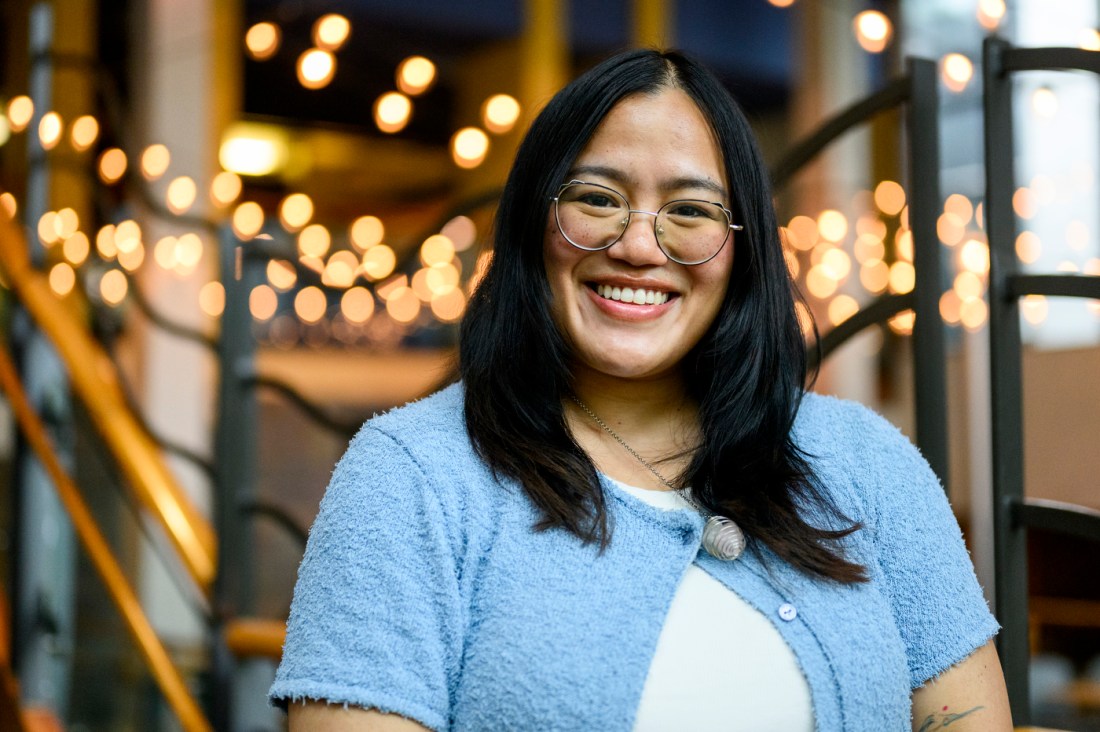How to eat well at college: 9 questions for Northeastern University’s campus dietitians
Feeding yourself can be a daunting part of the first-year campus experience. Gabby Cabacab and Johannah Gaitings-Harrod are here to help.

The first year of college is replete with new experiences and responsibilities, and among the most overlooked is also the most basic: eating.
For many new undergraduates, the first time independently choosing — and scheduling — all meals coincides with a daunting array of new options.
Gabby Cabacab and Johannah Gaitings-Harrod are dedicated to making it easier. As Northeastern’s Dining’s registered dietitians, they provide one-on-one nutrition counseling for students and help ensure that campus dining options in Boston and Oakland are inclusive, safe, tasty — and fun. Below, they dish on everything students need to know about feeding themselves at Northeastern.
What do campus dietitians do?
“We work within Northeastern Dining and provide assistance at Health Services,” says senior campus registered dietitian Cabacab. “[We] work very closely with all of the students who have food allergies or other dietary restrictions. We provide one-on-one nutrition counseling, which is a free service. There are also things like looking over menus and helping run dining services events.”
“I think students can get nervous to talk to dietitians,” adds Gaitings-Harrod, who works primarily with students on the Oakland campus. “But we’re here to help in any way we can.”


What food-related challenges do new students have?
“It’s common to feel overwhelmed,” Cabacab says. “Sometimes students — especially international students — are exposed to foods they’ve never seen before, and the large selections in our dining locations can be a lot.”
Gaitings-Harrod points out that as new students navigate structuring their own days, mealtime can get lost in the shuffle. “In high school, you wake up, have breakfast, go to school, there’s a very strict lunchtime, there’s a very strict dinnertime. Here, you have to plan.”
How do you make sure students are getting the nutrition they need?
In counseling, the dietitians emphasize the “Power Four” — making sure every meal has a protein, a carb, a source of fat, and a source of fiber. They also encourage using the USDA’s MyPlate as a handy reference for building a balanced meal.
Editor’s Picks
Additionally, residential dining locations —including The Eatery at Stetson East, United Table at International Village and more in Boston; Founders Commons in Oakland — are designed to encourage that balance. Every station has a protein, carb and vegetable, and students should feel free to mix and match based on their preferences.
“It’s OK to get a chicken from one station and a rice from another and a vegetable from another to build that healthy plate,” Gaitings-Harrod says.
What accommodations are there for students with allergies, faith-based diets and other special dietary needs?
“Anyone with a food allergy should reach out to us as soon as possible,” Cabacab says. “In International Village and Stetson East, we also have a station called Delicious Without — all of the food is free of the top nine allergens, including gluten. And everything is cooked and prepared within that station to prevent cross- contact.”
All food in the dining locations carries labeling for things like vegetarian and gluten-free diets avoiding gluten, and is cooked and prepared without nuts.
“We do have individual packets of [things like] Nutella, almond milk and peanut butter, but none of the food is cooked with peanuts or tree nuts at all,” Gaitings-Harrod says. “If we get a substitute that has it, we don’t allow it in.”
What events and programming does dining services offer throughout the year?
In both Boston and Oakland, the dining locations host a welcome back barbecue, a pumpkin-carving event in October and gingerbread decorating around the holidays. Cabacab and Gaitings-Harrod do occasional takeovers of stations, highlighting global cuisines or seasonal produce. The dietitians are also active presences on the Boston and Oakland dining Instagram feeds. In one series, “Foodie Facts,” they offer context for food and nutrition trends — seed oils, for instance— swirling around the news and social media.
Where do you like to eat on Boston’s campus?
“At United Table, my favorite station is the Spice Bowl,” Cabacab says. “In the Curry Student Center, the Halal Shack is my favorite.”
What about Oakland?
“My favorite station in Founders Commons is Chef’s Table,” says Gaitings-Harrod. “The cuisine’s fun. There’s also a station at Oakland campus’ Tea Shop called Innovation Kitchen, where students vote on the concepts they want to see for the upcoming month on Instagram. That’s a fun one.”

What options are there for students ready to venture past the dining locations?
Prepaid Husky Dollars loaded onto a student ID can be used at a number of restaurants on and off campus. Some second and third-year students may be ready to try cooking for themselves; for them, Cabacab recommends the BudgetBytes recipe site.
Students can also join Gaitings-Harrod and Cabacab for occasional DIY tutorials on specific dishes, held in the residential dining halls throughout the year. Past tutorials have have included make-your-own trail mix, overnight oats and stuffed mushroom caps
Finally, what advice do you have for new students before they arrive?
“Approach dining with curiosity,” Cabacab says. “If you see something that sounds good but you’re not sure, ask for a small portion on your plate so that you can try it. You’re allowed to have fun.”
Gaitings-Harrod recommends considering meals in step with registering for classes or signing up for extracurricular activities. “Sometimes students like to load up their classes all at once, but then they don’t have a lunch break. So really think about planning schedules to include food, because there’s so much going on.”
Helpful links
Boston:
Navigating Food Allergies + Special Diets
Dietary Accommodations
Meet the Dietitian
Oakland:
Dietary Accommodations
Meet the Dietitian











